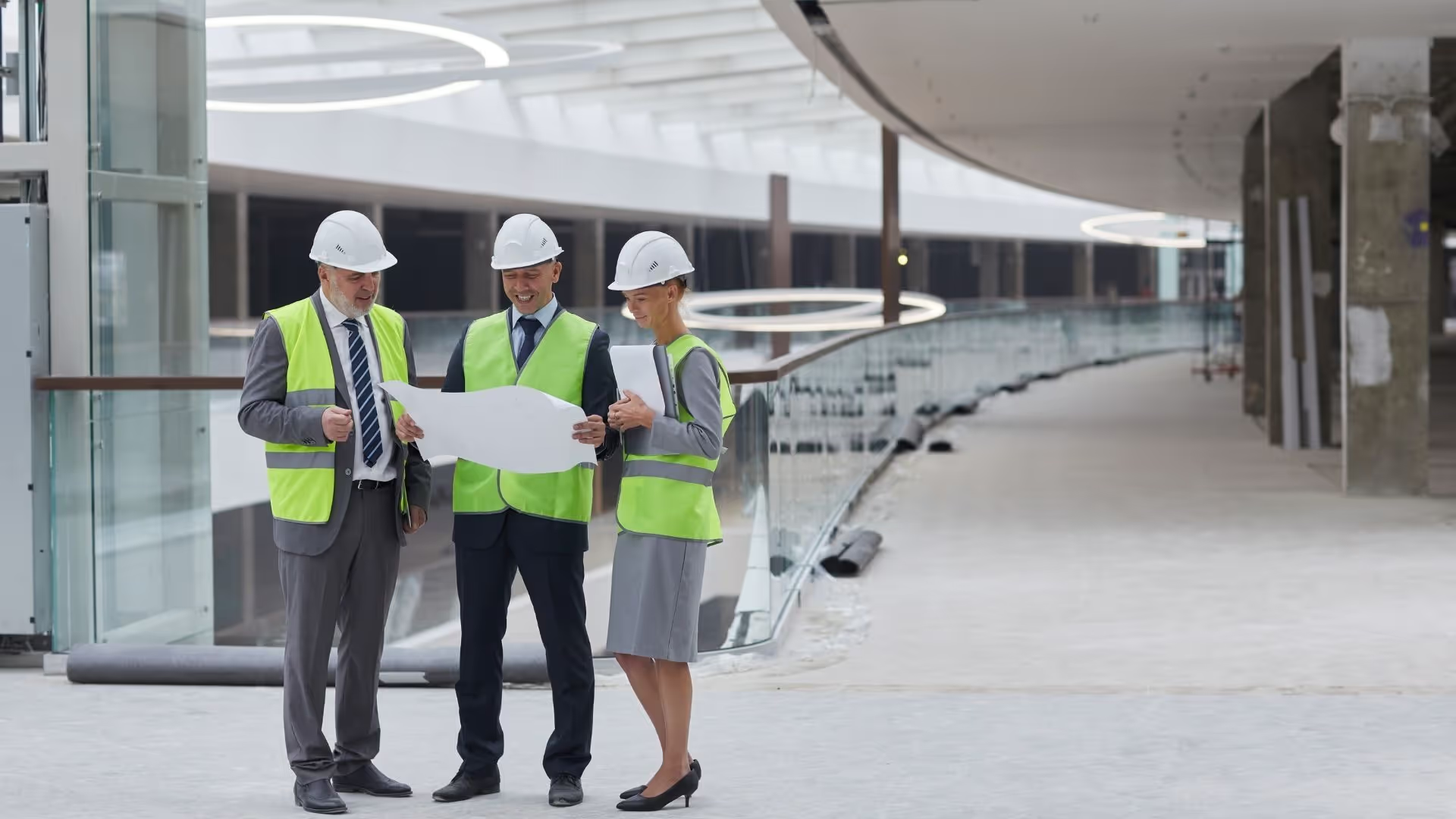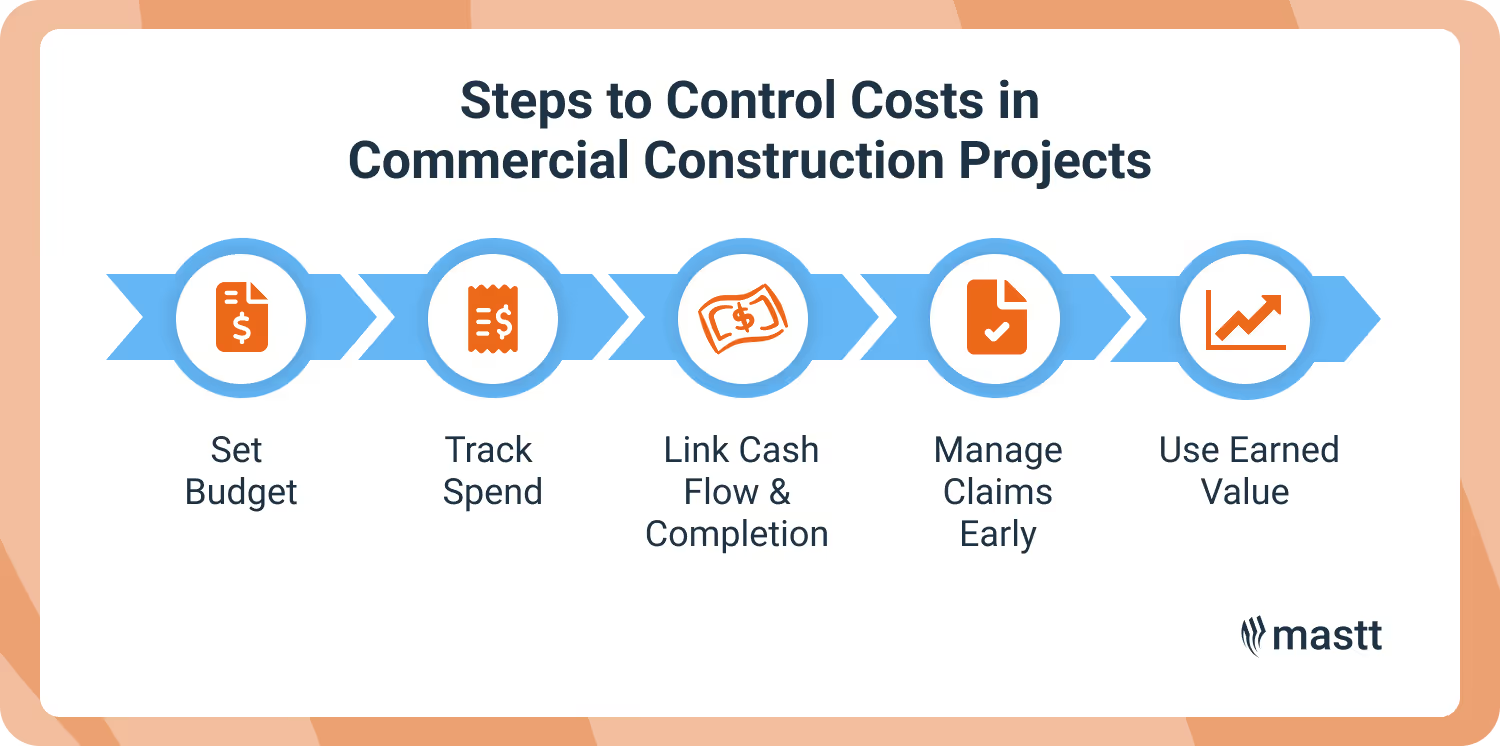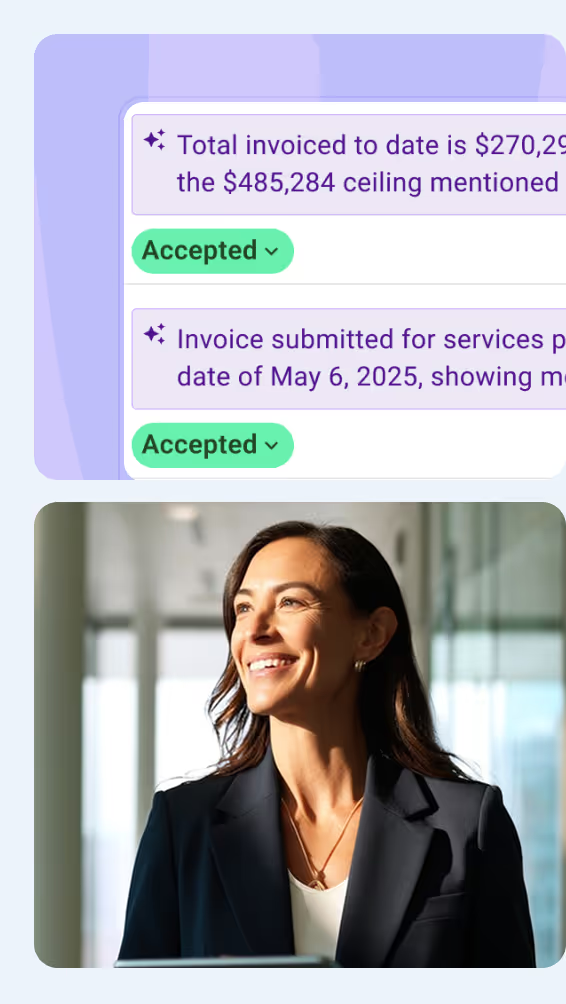Managing a commercial construction project means balancing time, cost, and quality without compromise. This article explains how they connect, why they must stay aligned, and the steps to achieve it. You’ll find practical techniques and tools trusted by professionals to deliver complex builds efficiently and to the highest standard.
What is Commercial Construction Project Management?
Commercial construction project management is the planning, execution, and oversight of buildings used for commercial purposes. These include offices, retail spaces, hospitality venues, and industrial facilities. It organizes resources, schedules, and budgets to ensure each stage is delivered efficiently and to scope.
A commercial project manager leads the process to keep work on schedule, control costs, and maintain build quality. They manage multiple trades, oversee safety and compliance, and ensure the finished facility meets operational needs and client expectations.
Effective commercial construction management reduces risk, improves communication, and ensures project goals are met on schedule. It provides owners and developers with a single accountable leader for delivering complex projects successfully.

Why Time, Cost & Quality Must Align in Commercial Construction Projects
In commercial construction, time, cost, and quality must align because each directly affects the others. A shift in project scope, budget, or schedule creates pressure that quickly spreads across the entire project.
To stay on track, a construction project manager must identify early signs of imbalance and make adjustments before delays or costs escalate.
Below are the common breakdowns across commercial projects**:**
- Unplanned scope growth: Triggers rushed work, missed inspections, and lowered build quality.
- Schedule delays: Push back trades, extend rentals, and raise project labor costs.
- Budget constraints: Lead to cheaper materials, reduced quality assurance (QA), and contractor change orders.
- Design changes mid-build: Require reapprovals, delay procurement, and disrupt coordination.
- Rework from quality issues: Break sequencing and reduce subcontractor availability.
- Compressed programs: Leave no buffer for testing, safety checks, or compliance tasks.
If your team owns design, align the scope and trade input early to avoid delivery risks. If consultants lead, involve builders before approvals to reduce rework and misalignment. Live project data and clear workflows help maintain cost, schedule, and quality, regardless of who controls the design.
What Makes Commercial Projects Harder to Control Than Other Builds?
Commercial construction projects are more complex to manage because they involve a larger number of people, stricter terms, and a higher level of risk. Compared to smaller builds, these projects move faster, cost more, and demand tighter coordination from start to finish.
Here’s what adds complexity to commercial projects:
To stay in control, project managers need clear scope definition, fast communication, and tight coordination across all stages. Each moving part must align early, especially when multiple teams share delivery responsibility.
How to Control Time in Commercial Construction Projects
Control time in commercial construction by using project milestones, sequencing, and live tracking from day one. When you monitor project delays and coordinate early, you minimize disruptions and keep the project on track.
The strategies below help construction project managers stay ahead of delays and protect overall delivery.
1. Use a Detailed Construction Schedule With Milestones
Milestone-based scheduling gives commercial PMs precise control over scope, timeline, and coordination. It breaks work into measurable deliverables, helping you track progress and hold teams accountable for their tasks.
- Split the schedule into handover stages.
- Assign milestone owners, dates, and signoffs.
- Link activities across trades and dependencies.
Milestones give project managers checkpoints to verify scope, track dependencies, and prevent downstream delays.
2. Apply Critical Path Method (CPM) or Lookahead Scheduling
Commercial project managers use the critical path method (CPM) and lookahead schedule to forecast and prevent delays early. Both methods improve coordination by identifying task sequences and time-sensitive work zones.
- CPM highlights task dependencies and float.
- Lookahead plans map short-term work over 2–6 week windows.
- Both tools reveal sequencing issues before they affect project timelines.
CPM and lookahead scheduling reveal time-sensitive risks early, allowing proactive adjustments to keep delivery on track.
3. Track Delays and Dependencies in Real Time
Tracking delays and task dependencies in real time helps commercial project teams stay ahead of disruptions. It keeps the project schedule aligned by flagging risks early, allowing construction managers to act promptly.
- Utilize commercial scheduling tools that provide live updates.
- Flag blocked tasks automatically for quicker intervention.
- Monitor trade handoffs and critical path sequences to ensure seamless execution.
Real-time tracking lets project managers resolve blockers quickly, preserving milestone dates and avoiding costly disruptions.
4. Monitor Construction Progress vs. Baseline
Tracking progress against a baseline gives project managers real-time visibility into schedule performance. Lock the baseline once scope, contract terms and conditions, and approvals have been set, then measure weekly.
- Set the baseline after confirming scope, contract, and design.
- Compare planned progress vs. actual weekly progress.
- Utilize visual dashboards to identify and flag variances quickly.
Monitoring against the baseline exposes performance gaps early, enabling corrective action before milestones slip.
5. Coordinate Work Packages and Long-Lead Items
Coordinating work packages and construction procurement ensures trades are moving smoothly and prevents delays on site. Plan to align material deliveries with construction sequencing.
- Identify long-lead materials early during planning.
- Confirm vendor timelines and track committed delivery dates.
- Lock in procurement before critical path work begins.
Tight coordination helps avoid idle labor and keeps the commercial construction projects on schedule.

How to Control Costs in Commercial Projects
Cost control in commercial construction begins with accurate budgets and is maintained through real-time financial tracking. Without visibility into commitments and forecasting, even minor overruns can escalate into significant issues.
Utilize these structured processes to identify risks early and protect your margin.
1. Set a Realistic Budget with a Clear Cost Breakdown
Start cost control by creating a detailed and realistic commercial construction budget. Break it down by scope, stage, and trade to avoid surprises.
- Define all cost categories, including labor, materials, equipment, and overhead.
- Align estimates with construction phases and delivery milestones.
- Include contingencies for design changes, inflation, and market risk.
A detailed budget linked to scope ensures spending stays accurate and overruns are caught early.
2. Track Commitments, Change Orders, and Forecasts Continuously
Ongoing cost control relies on real-time tracking of financial commitments and budget adjustments. Use real-time reports to stay ahead of overruns.
- Log every committed cost, change order, and supplier contract.
- Track approved vs. forecasted spend weekly.
- Flag deviations early to prevent cost blowouts.
Consistent tracking uncovers budget drift quickly, enabling prompt action to protect project margins.
3. Integrate Cash Flow and Cost-to-Complete Tracking
Linking cash flow to cost-to-complete helps you manage funding needs across every project phase. This keeps your construction project financially stable and on track.
- Map planned spend against payment terms and funding drawdowns.
- Forecast remaining costs based on current progress and variations.
- Update monthly to reflect real construction activity.
Linking cash flow to cost-to-complete ensures funding matches progress and prevents costly delivery gaps.
4. Control Claims and Change Orders Early
Unmanaged payment applications and change events can derail your budget and timeline fast. Establish clear rules to identify and address issues before they escalate.
- Require written approval for all scope or design changes.
- Review claim impacts on program, cost, and contract terms.
- Track unresolved items to avoid surprises at closeout.
Early claim and change order control reduces disputes, stabilizes budgets, and supports smooth project delivery.5. Use Earned Value Metrics to Monitor Cost Performance
5. Use Earned Value Metrics to Monitor Cost Performance
Earned value shows how your project budget aligns with real progress. It highlights overruns early so you can act fast.
- Calculate cost performance using planned value, actual cost, and earned value.
- Monitor Cost Performance Index (CPI) monthly.
- Combine with schedule data for accurate forecasts.
Earned value metrics connect progress to budget performance, allowing early corrections before costs escalate.

How to Maintain Quality Across Commercial Builds
Maintain quality across commercial builds by setting clear standards, aligning teams, and inspecting work continuously. It begins early and remains consistent throughout every stage to prevent rework and missed outcomes.
The steps below outline how to control quality at every stage of your commercial construction project.
1. Define Clear Quality Standards and Inspections
Quality control begins with setting clear expectations from the start. Without defined standards, inspections, and outcomes vary across trades.
- Document quality benchmarks using specifications and construction drawings.
- Include hold points, testing methods, and acceptance criteria.
- Set inspection frequency by trade and construction phase.
Defined standards give all trades a consistent benchmark, minimizing rework and inspection delays.
2. Align Consultant Deliverables with Construction Scope
Gaps between design and site execution cause delays, rework, and change orders. Aligning consultant outputs with actual construction requirements reduces this risk.
- Review consultant drawings against the trade scope before issuing for construction.
- Flag missing details or coordination issues early.
- Confirm that specifications match buildability and site constraints.
Aligning consultant outputs with site requirements prevents design gaps that cause costly delays.
3. Use Quality Checklists, Defect Logs, and Sign-Offs
Standardized quality tools help teams identify issues early and ensure that nothing is missed during handover. These tools ensure consistency across trades and provide managers with a clear audit trail during delivery.
- Construction Schedule Templates break high-value commercial builds into phases, assigns accountable parties, and locks in inspection milestones.
- Defect Logs record defect location, issue type, responsible contractor, and planned resolution.
- Project Status Reports summarize site progress, unresolved defects, and QA performance for owner and stakeholder review.
- Formal Sign-Offs ensure completed work meets specifications before progressing to the next commercial build stage.
Standardized QA tools create accountability, speed defect resolution, and maintain quality through each project phase.
4. Track Rework Incidents and Corrective Actions
Rework drains time, budget, and subcontractor availability; tracking it helps prevent repeat issues. Consistent rework tracking provides PMs with visibility into recurring problems and the effectiveness of their fixes.
- Record each rework incident by trade, cause, and location.
- Track how often and why the same issues occur.
- Document corrective actions and verify they’re followed.
Tracking rework trends identifies root causes, enabling targeted fixes that improve future build quality.
5. Link QA to Contractor Performance Reviews
Connect quality assurance to contractor performance reviews to improve accountability and outcomes. Consistent QA data ensures quality issues affect future work decisions, not just timelines.
- Include QA metrics in monthly contractor performance reviews.
- Highlight recurring defects, missed inspections, or poor documentation.
- Tie incentives or penalties to quality outcomes, not just speed.
Tying QA results to performance reviews improves contractor accountability and drives consistent build standards.

What Tools Help Manage Time, Cost, and Quality Together?
Utilize integrated construction tools to manage cost, schedule, and quality from a single source of truth. These tools enhance coordination, minimize delays, and maintain accountability among your project team.
The proper construction project management tools support real-time tracking across schedule, cost, and quality metrics:
- Live dashboards: Centralize time, budget, and quality metrics in one screen for quick oversight.
- Real-time reporting tools: Show delays, cost shifts, and risks instantly for faster decision-making.
- Audit logs and risk registers: Capture issues early and improve accountability across teams.
- Project control platforms: Combine contracts, claims, milestones, and cash flow in one system.
- Platform integrations: Sync consultant and contractor data without manual re-entry.
Connected systems such as Mastt, an AI construction project management software, give you real-time visibility and control across every phase of your commercial project.
Red Flags That Time, Cost, or Quality are Slipping
Common red flags include missed milestones, rising costs, unresolved RFIs, and recurring rework. These early signs show up in dashboards, forecasts, and subcontractor updates.
Watch for these early warning signals in project data and subcontractor updates:
❌ Schedule delays: Missed milestones or silence on key program dates.
❌ Cost pressure: Budget forecasts rising or vague, unexplained contractor claims.
❌ Quality decline: Recurring rework, inspection failures, or client complaints.
❌ Coordination gaps: Unanswered RFIs or unresolved scope questions.
❌ Subcontractor issues: Blocked trades, stacked work, or no clear resolution plan.
Flag schedule slippage, cost overruns, or QA gaps before they affect contract performance. Timely data supports corrective action.
What Project Managers Can Do to Stay in Control
Project managers maintain control by setting clear expectations and staying involved in commercial project decisions. You don’t need to manage daily tasks, but you do need structured oversight and fast access to data.
Here’s how to stay aligned with time, cost, and quality outcomes:
Staying engaged with approvals, reports, and meetings gives owners early risk visibility and decision-making control.
Control Starts with Visibility, Data, and Team Alignment
Project managers lead successful commercial construction projects by maintaining oversight, not by directing every task. Real-time construction dashboards and integrated data help surface risks early and keep teams aligned across cost, schedule, and quality.
When project managers stay engaged, consultants and contractors deliver with greater accuracy and fewer delays. Active involvement gives commercial project managers the visibility they need to make faster, better decisions.




















